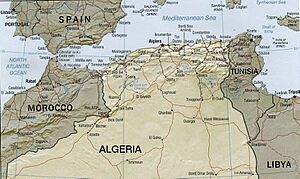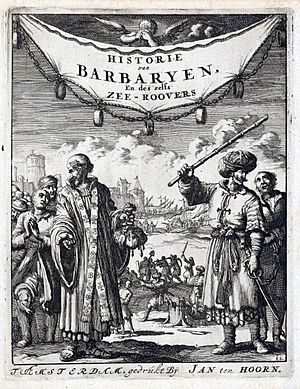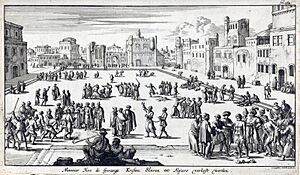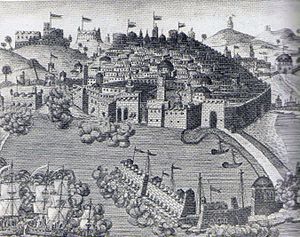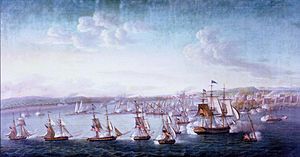Barbary slave trade facts for kids
The Barbary slave trade was a time when people were captured and sold as slaves in markets along the North African coast. These areas were known as the Barbary States. Muslim Barbary pirates captured Europeans during slave raids. They attacked ships at sea and raided towns along the coasts.
These raids happened from Italy all the way to the Netherlands, Ireland, and even as far north as Iceland. The pirates also operated in the Eastern Mediterranean Sea. For a long time, piracy was a big danger for ships sailing in these waters.
Contents
Who Were the Barbary Pirates?
The towns on the North African coast, like Tripoli, Algiers, and Tunis, had been known for their slave markets since ancient times. This continued into the Middle Ages. The Barbary Coast became more powerful in the 1400s. This happened when the Ottoman Empire took control of the area.
Many Sephardi Jews and Moors (Muslims from Spain) also came to this region. They had been forced to leave Spain after the Reconquista. With the Ottoman Empire's protection and many new people, the coast became famous for piracy.
The Rise of Pirate Power
After a revolt in the mid-1600s, the Ottoman rulers in the Barbary States lost much of their power. Towns like Tripoli, Algiers, and Tunis became almost independent. Without a strong central government, the pirates gained a lot of influence.
In 1785, American leaders Thomas Jefferson and John Adams met with an ambassador from Tripoli. They asked him why the pirates captured people. He said it was based on their religious laws. He explained that it was their right and duty to wage war on nations that did not follow their authority. They believed they could make slaves of anyone they captured.
Raids and Captives
The Barbary pirates raided ships and coastal towns. They attacked places in Europe and along the African Atlantic coast. Reports of these raids come from the 1500s to the 1800s. They happened in Italy, Spain, France, Portugal, England, Netherlands, Ireland, Scotland, Wales, and even Iceland.
Historians estimate that between 1 million and 1.25 million Europeans were captured. These people were sold as slaves in Tunis, Algiers, and Tripoli. Most of the captives were sailors taken from their ships. But fishermen and villagers from coastal areas were also captured. Many of these captives were from lands close to Africa, especially Italy.
Famous Raids
In 1544, a pirate leader named Hayreddin Barbarossa captured the island of Ischia. He took 4,000 prisoners. He also enslaved thousands of people from Lipari. In 1551, another pirate, Dragut, enslaved almost everyone on the Maltese island of Gozo. Between 5,000 and 6,000 people were sent to Ottoman Tripolitania.
In 1554, Dragut's pirates attacked Vieste. They captured 6,000 people. The Balearic Islands were attacked in 1558, and 4,000 people were taken as slaves. In 1618, Algerian pirates attacked the Canary Islands, taking 1,000 captives.
Some towns, like Baltimore in Ireland, were completely abandoned after a pirate raid. They were only settled again many years later. Between 1609 and 1616, England lost 466 merchant ships to Barbary pirates.
What Happened to Captives?
While pirates stole goods from ships, their main goal was to capture non-Muslim people. These captives would then be sold as slaves or held for ransom. People who had family or friends who could pay for their freedom were held captive. The famous writer Miguel de Cervantes was held for almost five years.
Others were sold into different types of forced labor. If captives converted to Islam, they were usually freed. This was because Muslims were not allowed to be enslaved. However, this meant they could never return to their home countries.
Some Christian Europeans, called renegades, converted to Islam and joined the pirates. Many of them were not slaves before. They came to North Africa looking for opportunities.
Decline of the Slave Trade
In the early 1800s, the United States and European nations fought the Barbary pirates. These were called the Barbary Wars. These wars were a direct response to the pirate raids and slave trade.
In 1804, a US Navy expedition attacked gunboats and forts in Tripoli. In 1816, British and Dutch warships heavily attacked Algiers. This forced the ruler of Algiers to agree to release 1,200 slaves. He also promised to stop enslaving Europeans.
Despite these efforts, the slave trade continued for a while. It finally ended when France conquered Algeria in the 1830s. Tunis was also invaded by France in 1881. Tripoli returned to Ottoman control before Italy took it over in 1911. As European powers took control, the slave traders had to follow new laws. The Barbary slave trade eventually disappeared in the 19th and 20th centuries.
See also
- Barbary corsairs
- Barbary Wars
- North African slave narratives
- Republic of Salé
- Slavery in the Ottoman Empire
- Turkish Abductions



